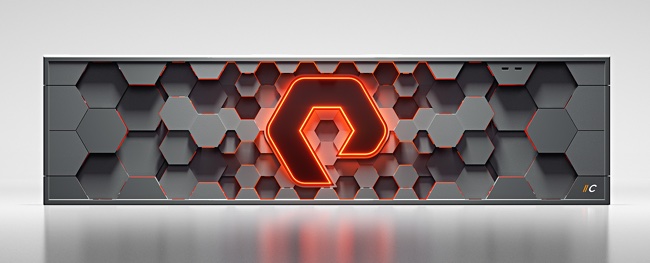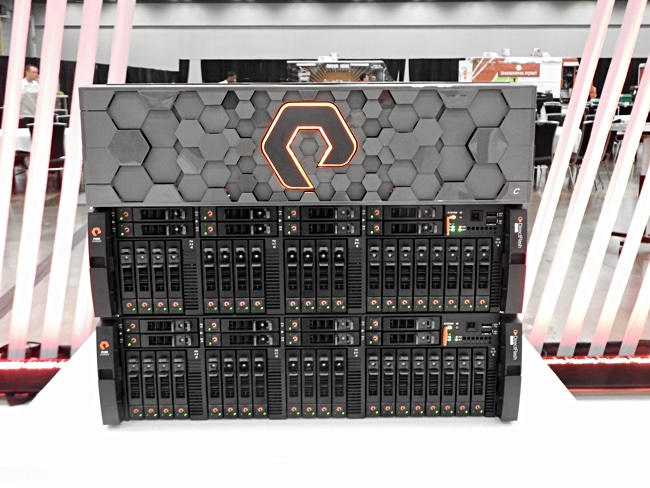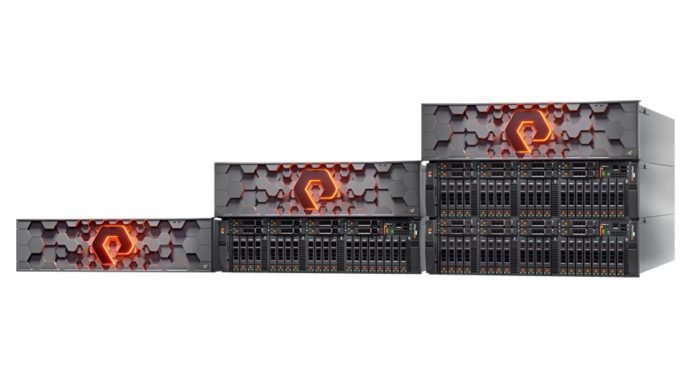Pure Storage has lined up a series of launches for day one of its Accelerate customer event in Austin, Texas that see the company’s hardware go faster, go larger, go nearline, go to subscriptions and get smarter VM analytics.
It has juiced up FlashArray//X with Optane, doubled FlashBlade capacity, announced a FlashArray//C for nearline storage use and is to make every product available as a service.
DirectMemory Modules
As we wrote a few days ago the FlashArray//X70 and //X90 models get read caching with Direct Memory Modules that carry 750GB of Optane storage-class memory. This is a non-disruptive upgrade for customers with workloads qualified by Pure.
Users could get as much as 50 per cent cut in latency depending on their workload read IO profile but there is no hard and fast rule. Pure said 80 per cent of its installed //70-90 arrays should see 20 per cent lower latency, with 40 per cent seeing 30 to 50 per cent latency reduction.
FlashArray//C
The FlashArray//C provides a slower and capacity-optimised tier of storage than the latency-optimised //X and uses DirectFlash modules fitted with QLC (4bits/cell) flash chips.

There are three //C configurations:
- 366TB raw – 1.3PB effective with 4:1 data reduction
- 878TB raw – 3.2PB effective
- 1.4PB raw – 5.2PB effective (FlashArray//C 60)

The module capacity is 18.3TB and there are 20 modules in the base configuration. Averaged end-to-end, read and write latency is 2 to 4 msecs – faster than disk arrays. Pure said //C systems could replace many racks of nearline disk arrays and open up new use cases for all-flash arrays.
Pure is not revealing the specific endurance of these QLC modules. It has written flash management software to handle QLC flash read retention and read disturb problems. This has reduced the write burden enough for the company to offer the same Evergreen device fail/replacement guarantees as for the FlashBlade and FlashArray//X.
Alex McMullan, international CTO, said in a interview, that Pure will ship //C arrays with TLC (3bits/cell) chips until QLC chip availability is mainstream. The array software and module firmware can cope with this and, as a byproduct, it extends the TLC module endurance. He said customer reaction to //C arrays were so positive that Pure has brought forward the launch, originally slated for next year.
A source close to Pure said QLC will be available next year, in 24TB modules. That will increase capacity presumably.
The //C system is pitched as a storage tier for test and dev work using production data from //X, to hold snaps from //X and as a disaster recovery resource for //X. Pure does not expect it to cannibalise low-end //X sales.
Unifying file and block
Pure’s //X and //C arrays offer block access. The company bought scale-out NAS software supplier Compuverde in April this year and is integrating its technology into the Purity software that runs the //X and //C arrays.
The company thinks large customers want separate file and block arrays whereas mid-range and smaller customers want a unified file+block system. A Compuverde-integrated system is in the works and should be ready in 2020.
On the file/object front Pure is doubling the capacity of FlashBlade arrays, from 75 blades to 150, giving 8PB effective capacity. The AIRI system, which uses FlashBlade as a component, is being extended into an A’I Data Hub’. This will include Kubernetes and Amazon S3 support.
Pure-as-a-Service

Pure CEO Charles Giancarlo said in a press briefing that Pure’s ES2 Evergreen storage-as-a-service branding was confusing. The company has renamed it Pure-as-a-Service and will make all Pure products available on subscription.
This parallels what HPE is doing with its GreenLake service. Max Kixmoeller, Pure’s VP for strategy, said US accounting rule changes meant leases now had to be treated as CAPEX. The PaaS offering is OPEX.
A customer’s capacity licence can be transferred between on-premises Pure arrays and a Pure array running on AWS. But, unexpectedly, cloud capacity costs more, by an unspecified amount.
Cloud matters
CloudSnap, service with //X snapshots stored in AWS, is now available for Azure. Cloud Block Store, which runs on Amazon, is now generally available. It will also be ported to Azure. Pure will offer lower cost options, for instance, one with lower availability.
These moves position Pure as a multi-cloud service supplier. Over time we can expect the company to support the Google cloud.
Pure1VM Analytics, introduced earlier this year, has a Tier 1 VM Analytics Pro option offering smarter analytics. Pure believes that a transition is underway in its customer base from manual array management to API-based management, and AI tools are required to automate storage array management.
Availability
FlashArray//C, the Direct Memory Modules, Cloud Block Store for AWS and CloudSnap for Azure are all generally available. The expanded FlashBlade is on limited or directed availability as is Pure1 VM Analytics.








